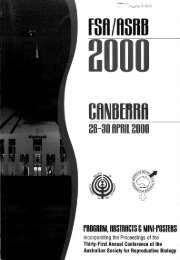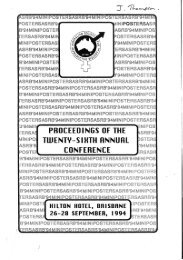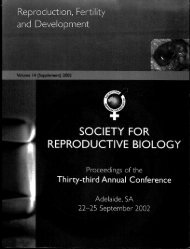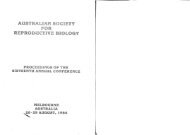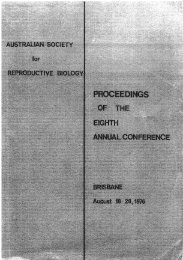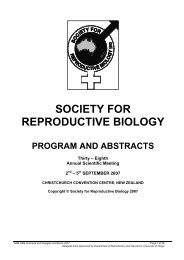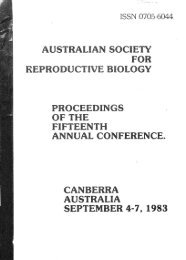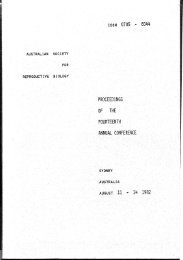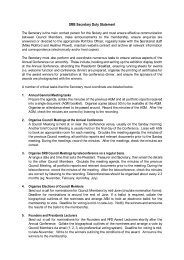N OCIETY' - the Society for Reproductive Biology
N OCIETY' - the Society for Reproductive Biology
N OCIETY' - the Society for Reproductive Biology
Create successful ePaper yourself
Turn your PDF publications into a flip-book with our unique Google optimized e-Paper software.
Plateletaactivating factor receptor in human and mouse spermatozoa and mouse preimplantation\.(~--. v~~J'"~e~~k- + h..............~~ j·v..... j..Ji.. t+T. Stojanov, C. Wu & C. 0 'NeillHuman Reproduction Unit, RNSH; Department ofPhysiology, University ofSydneyIntroductionPlatelet activating factor (PAF, 1-0-alkyl-2-acetyl-snglyceryl-3-phosphocholine)is a potent e<strong>the</strong>rphospholipid. It improves motility and inducesacrosome reaction in spermatozoa and acts as anautocrine growth/survival factor <strong>for</strong> <strong>the</strong> preimplantationembryo. The concentration of PAF in spermatozoa andembryos is inversely related t6 <strong>the</strong>ir quality. Amechanism of action is yet to be defined. In this study,we examined <strong>the</strong> expression of a G-protein linkedreceptor to PAF (PAF-R).We have previously shown (1) that PAF-R mRNAtranscripts were detected in freshly fertilized mousezygotes. By <strong>the</strong> late I-cell stage and 2-cell stageexpression was less consistent but was observedconsistently again from <strong>the</strong> 4-cell stage up until <strong>the</strong>blastocyst stage. IVF and culture delayed <strong>the</strong> expressionof PAF-R mRNA until <strong>the</strong> 8-cell compacted stage.This study investigated: (i) <strong>the</strong> presence of PAF-RmRNA and protein in <strong>the</strong> human and mousespermatozoa; (ii) <strong>the</strong> presence of PAF-R protein inmouse preimplantation embryos and its pattern ofexpression following in vitro fertilisation and culture(IVF).Materials and methodsGamete collection and cultureSpermatozoa were obtained from three fertile donors(human) or were aspirated from cauda epididymis' offertile males (mouse). Motile spermatozoa were <strong>the</strong>nseparated by swim up into modified-RTF.Mouse embryos were collected fresh from reproductivetract (fresh) at various stages during preimplantationdevelopment. IVF embryos were cultured in modifiedRTF. Embryos were immunostained 17, 27, 42, 66 and90 hours post hCG.RNA extraction and RT-PCRRNA was extracted from spermatozoa with TRIzolReagent (Gibco). RT-PCR was per<strong>for</strong>med on spermsamples under standard Perkin-Elmer conditions usingspecific primers <strong>for</strong> PAF-R.ImmunofluorescenceSpermatozoa or embryos at various stages ofdevelopmental were fixed in 70% ethanol or 2%para<strong>for</strong>maldehyde (respectively), permeabilised in 1%Tween 20 (embryos) and non specific binding blockedwith 30% sheep heat inactivated serum. Immunotaggingwas per<strong>for</strong>med by incubation of gametes withmonoclonal antibody to PAF-R (human) (Alexis Corp.)followed by incubation in secondary fluorescent FITCanti-mouseIgG (Santa Cruz Biotechnology).Spermatozoa and embryos were viewed with anepifluorescent microscope (Nikon).ResultsPAF-R mRNA and protein were present in all samplesof human and mouse spermatozoa tested.Immunostained human spermatozoa showed specificstaining which was most prevalent at <strong>the</strong> midpiece and98distal head (Fig. 1). PAF-R location in mousespermatozoa was most prominent at <strong>the</strong> midpiece(Fig.!).Immunostaining of embryos collected fresh from <strong>the</strong>reproductive tract was significantly greater than isotypecontrols and <strong>the</strong> intensity was not different from <strong>the</strong> 1cell up to blastocyst stage. During development <strong>the</strong>pattern of PAF-R localization changed from diffusecytoplasmic staining in zygotes to increasinglymembrane localized pat.tern of expression from <strong>the</strong> 2cell stage onwards. There was no effect of IVF on <strong>the</strong>level and pattern ofprotein expression.Figure 1: PAF-R protein in human and mouse spennatozoa.i) human spennatozoa, ii) mouse spennatozoa, iii) mousespennatozoa incubated in non-immune IgGFigure 2: PAF-R protein in mouse preimplantation embryos.i) i-cell zygote, ii) 2-cell embryo, iii) 2-cell embryo incubatedin non-immune IgG iv) 4-cell embryo v) 8-cell embryo vi)blastocyst.ConclusionsThe results of this study showed that mRNA and protein<strong>for</strong> <strong>the</strong> G-protein linked PAF-R is present in human andmouse spermatozoa and within <strong>the</strong> mousepreimplantation embryo. Unlike <strong>the</strong> expression ofmRNA in embryos, <strong>the</strong> onset of PAF-R proteinexpression was not delayed following IVF and culture.(1) Stojanov T. & O'Neill C. (1999). Bioi Reprod 60(3):674-82Figure 1325~300.s 275o6 250u as 225u :u 200~ 175~ 150.5 125100o2 4Time (min)medium containing albumin (-, n=50) or no albumin(., n=50).8.- ~~ --b ~~~i- ~~f ", ~ ...;....JL-.\.d- ...Embryo-derived PAF induces Ca 2 + transients in <strong>the</strong> mouse preimplantation embryoR. Bathgate, M. Emerson, A. Travis and C. O'NeillRuman Reproduction, Department ofPhysiology, University of Sydney, Royal North Shore Hospital,St Leonards, NSW, 2065Introduction' .Platelet-activating factor (PAF) is an autocrine factor involved in regulation of embryo development. Its mecha~lsm ofaction remains to be defined. Transient increases in intracellular calcium are universal cues <strong>for</strong> cell-cycle progressIOn andregulation of differentiation and development. Exogenous PAF was S?own to induce a ~ansient rel.ease of i~trac~llularcalcium. In this study we investigate whe<strong>the</strong>r endogenous embryo-denved PAF can also Induce calCIUm tranSIents In <strong>the</strong>2-cell embryo.Meilio~ .Female mice were superovulated by Lp. injection of 10 IU eCG followed 48h l~ter by 10 ill hCG and mated overmght.Embryos were flushed from <strong>the</strong> oviducts of mice at <strong>the</strong> 2-cell stage of development 42h after eCG. Embryos wereincubated in Fura-2-AM (2uM) <strong>for</strong> 30min and <strong>the</strong>n mounted on a coverslip coated with Cell-Tak and sealed onto aperspex perfusion chamber. Embryos were monitored with Ion Vision software package and changes in Fura-2 ratio(calculated using excitation wavelengths of 340 and 380 nm) recorded.Results and DiscussionRelease ofPAF from embryos requires albumin (1) <strong>the</strong>re<strong>for</strong>e calcium measurements were made in media in <strong>the</strong> pres.en~eand absence of BSA. In <strong>the</strong> presence of albumin embryos showed characteristic calcium transients but did not do so In Itsabsence (Figure 1). It was determined that this transient was due to embryo-derived PAF by showing that addition ofrecombinant PAF:acetylhydrolase (it degrades PAF to an inactive metabolite) prevented <strong>the</strong> transient. These embryosstill responded to exogenous PAF with a calcium transient illustrating <strong>the</strong> specificity of <strong>the</strong> response. ~ PAF-r~cept~rantagonist (WEB 2086)' also blocked calcium transients. Depletion of Caj stores by -treatment WIth thapslgar~Ineliminated <strong>the</strong> observed calcium transient, suggesting that it is reliant on Caj stores (Figure 2). Embryos superfused WIthmedium containing 3ug/ml BSA responded more quickly and with a greater amplitude than those exposed to 3mg/mlBSA, suggesting that BSA competes with <strong>the</strong> PAF receptor <strong>for</strong> PAF.Figure 1.The change in [Ca 2 +]j in response to perfusion Figure 2.The [Ca 2 +]j response of 2-cell embryos to PAFFigure 2550~ 500.s450§U 400asU 350:s :03001 250:E 200••••••SHS&BB••eeBB B ••1 5 0 ~--r--.----r-..-----'2 4 6 8 10Tim e (m in)after depletion of internal stores by thapsigargin.Thapsigargin treated (-, n=63), control Ce, n=49).Embryos exhibit a transient release of internal calcium stores in response to embryo derived PAF during <strong>the</strong> 2-cell stage.It is dependent on <strong>the</strong> presence of BSA. Previous studies have routinely excluded albumin and have <strong>the</strong>re<strong>for</strong>e not beencapable of detecting <strong>the</strong> actions of embryo-derived hydrophobic compounds.Reference(1) Ammit, AJ. and O'Neill, C. (1997) Studies of <strong>the</strong> nature of <strong>the</strong> binding by albumin of platelet-activating factorreleased from cells. Journal ofBiological Chemistry. 272: 18772-78.99



